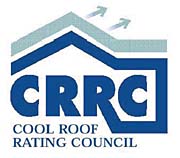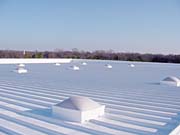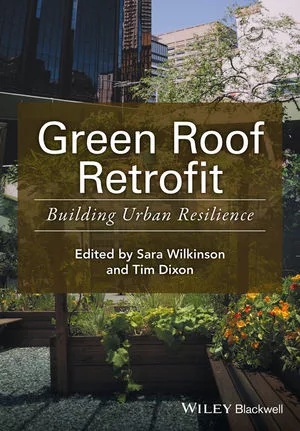Cool Roof Update
It may be a clich by now to say that cool roofing is a hot topic, but there have been important developments in this area of the industry. Two things to keep an eye on in the coming year are a new product rating system from the Cool Roof Rating Council and the implementation of the City of Chicago’s Energy Conservation Code.

Cool Roof Rating Council Launches Product Rating Program
We first spoke to Jim Leonard, who is president of ERSystems, Loretto, Minn., and a member of the board of directors of the Cool Roof Rating Council. The CRRC was created in 1998 to develop an accurate and credible method for evaluating and labeling the solar reflectance and thermal emittance (radiative properties) of roofing products. The next step is to disseminate this information to all interested parties. A non-profit, educational organization, the CRRC’s mission also includes supporting research into energy-related properties of roofing surfaces and providing education and objective support to parties interested in understanding and comparing various roofing products.Leonard says, “The CRRC has launched its Product Rating Program after three years and a lot of work on the part of dozens of roofing professionals.” Roofing material manufacturers and CRRC-licensed sellers of roofing materials began submitting CRRC ratings program applications and samples for testing in October 2002. Those members of CRRC who chose to participate in the program immediately are being designated “Charter Members.”
The CRRC’s program encompasses the following elements:
Roof material manufacturers submit samples to Independent Accredited Testing Laboratories that measure and report results per CRRC-approved ASTM tests.
A CRRC-trademarked label and CRRC directory listing will be used to report the data to “users” of the rating system.
A random-sampling program allows the CRRC to monitor compliance to the label.
“Users” of the CRRC-Product Rating Program will include:
1. Building designers, architects and engineers who will use the program to size HVAC equipment and estimate building energy loads.
2. Building code officials who will use the program to develop and monitor compliance to construction code.
3. Energy providers and planners who will use the rating system to project power needs and provide energy-related incentives to building owners.
As we reported in the February 2002 issue of Roofing Contractor, the California Energy Commission has declared the CRRC as the “supervisory entity” for performance ratings of roof surfaces with respect to California Title 24 Building Energy Code; establishing the CRRC program as the only recognized source of data for code compliance. The first CRRC-rated Products Directory became available for reference in January 2003.
According to Leonard, “It is expected that end-users in other state and municipal code bodies will have immediate interest as well. Although cool roofing is recognized within Title 24 right now, the proposed updates to Title 24 (scheduled to become effective Jan. 1, 2005) strongly encourage cool roofing applications for non-residential buildings.”
Under the CRRC’s product ratings program, initial and 3-year aged values for solar reflectance and thermal emittance will be reported. The 3-year aging protocol is the one major task that is still in development by the CRRC. Accordingly, the ratings program will report initial values only as the program begins operations.
“Manufacturer participation in the CRRC Product Rating Program will provide competitive advantage to high-performing products in California, and, in all likelihood, soon around the rest of the country,” says Leonard. “Interested manufacturers and potential users may review the program and get more detailed information at www.coolroofs.org. The CRRC will continue to develop educational and marketing outreach programs to inform the public and potential users of the Product Rating Program about the importance of cool roofing in reducing energy usage, reducing electrical peak demand, and reducing consumer electric bills while benefiting the environment.”

Chicago Energy Code
Another topic in cool roofing that has many in the industry hot under the collar is the Chicago Energy Conservation Code, which went into effect Sept. 3, 2002 – except for the part that pertains to roofing.According to the Chicago Department of Buildings’ Web site, the energy code was originally developed jointly under the auspices of the Council of American Building Officials, Building Officials and Code Administrators International Inc., the International Conference of Building Officials, the National Conference of States on Building Codes and Standards, and Southern Building Code Congress International Inc, under a contract funded by the U.S. Department of Energy.
The code requires that building plans be submitted with a compliance statement by a Registered Energy Professional or a statement that compliance is not required. The Web site also says, “The Chicago Energy Conservation Code provides multiple paths for demonstrating code compliance including prescriptive, performance and acceptable practice approaches. User-friendly software — MECcheck for residential and COMcheck for commercial buildings — provides flexibility and makes determining compliance much easier.”
The part of the energy code that applies to roofing is section 18-13-303 “Urban Heat Islands.” Currently, a proposed amendment to this section is under consideration by the Council Committee on Buildings. Language approved by the City Council for an amended 18-13-303, Urban Heat Islands, will be enforced following its passage.
The reflectance and emittance requirements of Section 18-13-303.1 through 18-13-303.2 are intended to minimize the urban heat island effect, as defined in Section 18-13-202. The exceptions:
1. The portion of the roof that is covered by a rooftop deck covering 1/3 or less of the aggregate area of the roof, or a rooftop garden, or a green roof, is exempted from the requirements of this section.
2. An area including and adjacent to rooftop photovoltaic and solar thermal equipment, totaling not more than three times the area that is covered with such equipment, may be exempted from the requirements of this section. All roof exterior surfaces, other than metal and metallic coatings, shall have a minimum solar reflectance as specified in Table 18-13-303.2 (see below) when tested in accordance with ASTM E909, ASTM E 1918 or by testing with a portable reflectometer at near ambient conditions.
According to Kristen Cabanban, director of communications, Department of Buildings, City of Chicago, “Commissioner Roberson has been conferring with the roofing industry and is in the process of evaluating the information many have provided. Our Web site at www.cityofchicago.org/buildings currently reflects what we propose, however, this may or may not change once the commissioner has completed his evaluation.”
And what exactly is the commissioner evaluating?
To get the roofing industry’s side of the issue, we spoke to Rodney Petrick, of Ridgeworth Roofing Inc., Bridgeview, Ill., a Chicago-area company that does commercial, industrial, institutional and residential work. Petrick is also the secretary and second vice president of the Chicago Roofing Contractors Association, as well as a member of the Midwest Roofing Contractors Association’s Technical & Research Committee.
Petrick says that he was thrown into the Chicago Energy Conservation Code saga a little over a year ago when the process of trying to make modifications to the roofing portion began. The “Urban Heat Island” section is now in its fourth stay of enforcement.
The CRCA is part of the Roofing Alliance, an informal group of manufacturers, contractors, engineers and union labor working together to gather information to reinforce its position. The Roofing Alliance includes the United Union of Roofers and Waterproofers, Local #11, CRCA, National Roofing Contractors Association, Asphalt Roofing Manufacturers Association, Roof Coatings Manufacturers Association, and some Chicago-based roofing manufacturers. The Alliance has the assistance of several well-known technical types, including Rene Dupuis, president of Structural Research Inc., Middleton, Wis. and Andre Dejarlais of Oakridge National Laboratories.
At issue, according to Petrick, is Chicago’s reflectivity requirement of .65. “It’s hard to go from having no requirements to this number, and after .40, you wipe out a lot of standard systems,” he says.
Chicago area roofers have other concerns with the building code as well. Petrick cites the following: 1) Permitting. Currently, there is no trade-specific permit for roofing in the city. Roofers have to use a building permit, which, according to Petrick, is confusing for everyone concerned. 2) The residential side of the code, which Petrick describes as “pretty gray.” 3) The requirement that a registered energy professional sign off on the permit. 4) R-values. The Alliance is trying to get the city to agree on a minimum R-value of R-20, which also contributes significantly to a building’s energy efficiency.
According to Petrick, the city has tabled other issues and won’t consider them until reflectivity is settled. “It’s all in limbo,” he says.
CRCA and the Alliance agree that roofs need to be more reflective, “But on some buildings the requirement (.65) just won’t work,” says Petrick. “You can’t mandate out other roofing systems.” As for aged values, there is little information currently available. And while Energy Star permits washing a roof to test the aged value, “Who is going to wash all those roofs and is the city prepared to handle the run-off?” Petrick asks.
At press time, negotiations were continuing. The Alliance had a meeting with the building director in September during the MRCA convention. “He asked for data and we delivered an interim report on Nov. 25,” says Petrick. “It is currently under review by building and environmental departments.”
Stay tuned. Roofing Contractor will continue to monitor developments in this area.
Links
Looking for a reprint of this article?
From high-res PDFs to custom plaques, order your copy today!



